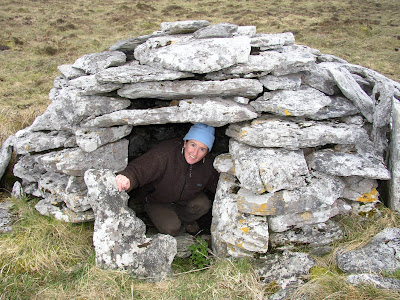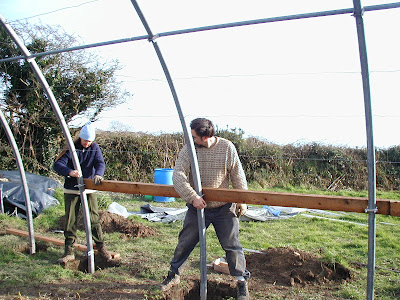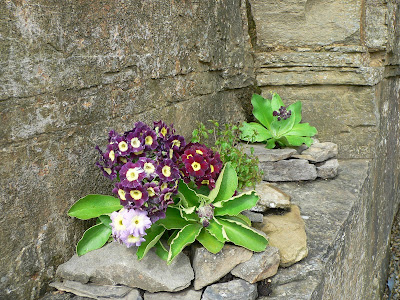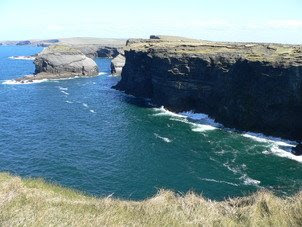This is the story of our move from Ithaca NY, a place I love very much (and for which I still pine on the harder days), to a rustic thatched cottage in the hills of County Clare, Ireland. I feel like I'm married to America and having a fling with Ireland.
Bill and I, both in our mid-40's, thought we had finally settled down. We were living in a beautiful passive solar house near Ithaca that we built ourselves, surrounded by a huge vegetable garden, fruit trees, and gorgeous flower gardens. We had worked hard for years, building and gardening, to create our own little paradise. We were both fortunate to have steady, fulfilling work that paid the bills and a great social life in beautiful Ithaca, a progressive university town with a rich offering of artistic and academic culture.
We left a lovely, handbuilt home... with an attached greenhouse...
with an attached greenhouse... and beautiful gardens...
and beautiful gardens...
 ...in the hills of upstate New York.
...in the hills of upstate New York. We left behind our fun and crazy friends....
We left behind our fun and crazy friends....
 ...and family
...and family



 2004: A ten-day holiday in County Clare
2004: A ten-day holiday in County Clare Then in 2004 everything changed. I found out I was eligible for Irish citizenship by descent, an unusually liberal policy that means anyone with at least one grandparent born in Ireland can apply for citizenship. I found this out around the same time that we were feeling utterly disgusted with the way the Bush administration had used 9/11 as an excuse to invade Iraq, and apprehensive about the upcoming election, in which Bush had a good chance of getting re-elected. With Irish citizenship, it might be possible to get away from American policies for a while and experience life in another country. This was an intriguing idea, but still a remote fantasy since neither of us had ever been to Ireland and didn't have a clue as to what it was really like. I held contradicting images in my mind of green, green hills and IRA bombers.
We came to Ireland for the first time for a 10 day vacation in spring of 2004, with our 18 year old daughter. Monica was just about to finish high school, so the trip was a long-promised graduation gift to her as well as a chance to to check out Ireland as a possible place to live. We had a fantastic time - to say we loved our time in County Clare would be an understatement. What I felt more than anything was a sense of recognition and familiarity, as if I were traveling through a landscape I had visited many times in my dreams. I saw so many facets of my personality reflected in the people we met - the easy way I talk to strangers, my love for music, an awe for the wild power of nature. It was as if the last few pieces of my jigsaw puzzle had always been missing and now they had finally fallen into place. I know it sounds like the usual cheesy romantic goop that is spouted by everyone who comes to Ireland in search of their roots, but in my case the powerful sense of identification was strong enough that just seeing Ireland on one holiday wasn't enough. It was as if I was under a spell, and after our trip I could think of nothing else but returning to Ireland to experience more of this feeling.
Images from our first trip to Ireland. We were hooked.




 2005: 10 months WWOOFING in the west of Ireland
2005: 10 months WWOOFING in the west of Ireland However, I wasn't quite ready to chuck everything and move to Ireland just yet. It would have been easier when we were still in our early 20's and not so settled down. I recognized that the symptoms of infatuation might be temporary, so we looked into ways to travel around Ireland cheaply for a good long time, and still keep our house and jobs in the United States. Finally we found the answer through WWOOF, World-Wide Opportunities on Organic Farms. This organization facilitates an exchange program between organic farmers who need help and people who want to learn about farming while traveling around. The volunteers, called “wwoofers”, work for a pre-arranged number of hours per week on the farms in exchange for meals and a place to stay. By wwoofing in Ireland, we were able to travel cheaply, see a fair bit of the country, and meet others with like-minded interests in organic farming and gardening.
We made all the necessary arrangements to leave our old lives behind for a year and started wwoofing in the west of Ireland in January 2005. We spent 10 months wwoofing in Counties Cork, Kerry, Clare, Limerick, Clare and Galway, staying with 12 different families overall. Many of our wwoof hosts were not professional farmers, rather they were small-holders with large vegetable gardens and some animals, trying to be more self-sufficient.
Wwoofing was challenging in the beginning. Missing our home, friends and pets, combined with a few challenging farm situations almost had me on the plane back to America before the first few months had passed. I kept a journal throughout the year, and set up a blog that was read by hundreds of Americans, friends, families and co-workers, back home.
After a rough experience with our second wwoof hosts we thought about giving up but decided to give wwoofing one more try before returning to the United States in defeat. Fortunately our next hosts were two of the sweetest people in the world. I would have adopted them as my grandparents and stayed forever but sadly we had to move on when our two weeks were up. After that point our wwoofing experiences were mostly positive, but more importantly I found I had developed a much better tolerance to the few hosts that were a bit prickly to live with. I no longer missed our home in Ithaca so much, and I found that I really enjoyed packing up and moving along every two weeks with no clue about what was in store for us at the next farm. At each home we spent lots of our free time cycling, walking, and exploring the surrounding area, so that by the end of 10 months we had probably seen more of western Ireland's hidden nooks and crannies than most Irish.
We stayed in all manner of accommodation.


 And we did all kinds of work.
And we did all kinds of work.



Once we got into County Clare and started wwoofing around Ennis we hit a lucky streak. Some call it “trail magic”, those serendipitous situations that happen when you throw your fate to the winds. It was summertime, holiday time, and we met a group of people who were looking for trustworthy house and pet minders while they were away. We were essentially homeless, very flexible, and delighted to stay for a week or two in one beautiful home after another – an architect's bright, spacious house surrounded by gorgeous, exotic gardens; a seaside cottage overlooking the Aran Islands; a lovely house in the town center of Ennis, with an easy walk to the pubs for traditional music. Once we had use of a homeowner lovely Audi, a novelty for us since we had been getting around Ireland strictly by bike and bus. As I drove into town (on the wrong side of the road), the Talking Heads song, “Letting the Days Go By” played in my head:
And you may find yourself living in a beautiful house,
And you may find yourself behind the wheel of a large automobile.
And you may ask yourself, “Well, how did I get here?”We cycled everywhere.....
 ...climbed a lot of mountains....
...climbed a lot of mountains....
 visited oodles of castles.....
visited oodles of castles.....

 and ogled the sexy summer wildflowers.
and ogled the sexy summer wildflowers.





As I settled into the rhythms of traveling and wwoofing I experienced more freedom than I had at any other time in my life. This was like being a teenager, but without the angst – we were only working part-time at something we both love, we had no bills to pay, no parental responsibilities, no car repairs, no job hassles. We did have wwoof hosts that, like parents, could sometimes be nice and other times be mean and repressive. But at least we could leave home and get a new set of “parents” every couple of weeks. I had become so unattached to our old routines that I felt reluctant to return to our settled lives in America. I fantasized about fixing up a camper van and driving around the rest of Europe and beyond, getting by as wwoofers and migrant farm laborers. But reality set in when we ran out of money, so we returned to our house and jobs in the United States before going too deeply into debt.
There is a common insect that lives in the still waters of ponds and swamps in America. The water strider glides around on the surface tension of the water, like an ice skater. Down in the southern states they call them “Jesus bugs” because they appear to be walking on the water. The water striders glide around eating tiny insects that either land on the water or come up to the surface from below, so they literally have the best of both worlds, water and air.

Being a water strider is what wwoofing felt like after a while. I could see down into the water where people were living their settled lives – content and comfortably trapped by jobs, mortgages, and raising children. With our grown daughter living in California, parents who were aging but still healthy, and no debt (other than our mortgage), we had an open window in our lives and we seized the opportunity to dive through it. We temporarily broke free of the chains that had tied us for so long, and were fortunate to spend almost a year skating above the surface of normal life.
 2006-2007:Back in America
2006-2007:Back in America We returned to America in the late fall of 2005, determined to save enough money to return to Ireland and try living a “real life” rather than just wwoofing. During the two years we were living in America we made three changes to our lives, inspired by our journey,. First, I finally learned to play an instrument. When we were wwoofing I was asked again and again if I played. In fact, I was asked many more times what instrument I played than what I did for a living, which is usually one of the first questions people ask in America. Musical talent is so common in Ireland that admitting that you can't play an instrument is like confessing you don't know how to read. I was not going to return to Ireland until I could play something, so I set about learning to play the banjo, choosing to learn the Apalachian old-timey style rather than Irish traditional music.

Second, we started our own “box scheme” for selling vegetables. This scheme was inspired by one of the Irish farms we wwoofed on that operated a vegetable delivery service. We had already been growing lots of veg for our own use, so we just ramped up the amount we normally planted and made customized deliveries to friends and co-workers. It was a good experience and we plan to start the same kind of veg delivery service here in Ireland when we develop more garden space.

Lastly, since the veg delivery business meant we had a lot more garden to manage plus full-time jobs on the side, we opened our home to wwoofers. It was an interesting experience to have the shoe on the other foot and host people who came with little or no farming skills. As former wwoofers, we understood what it was like to live in a stranger's home, and so did everything we could to provide a comfortable home for our wwoofers while establishing a work arrangement that was flexible and fair to everybody.
Lindsay and Will, our wwoofers from London
When we felt financially and emotionally ready to make a more permanent move to Ireland,there was no doubt about where we wanted to settle. We had made our best connections and had the best traveler's luck in Ennis, County Clare, and Clare had everything we were looking for: the rugged Atlantic coastline; the botanical wonders and weird moonscapes of the Burren; the wooded hills and lakes of east Clare, so reminiscent of the landforms of our Fingerlakes region in upstate New York; and the perfect size of the market town, Ennis – large enough to have a performing arts center and a lively, diverse culture, but small enough to have beauty and nature close at hand and a sense of community.
2008-Present:Living in County Clare After two years of saving money and making plans, we moved to County Clare in February 2008. When we were wwoofing it seemed like life would be much easier in Ireland once I got citizenship, so we could have our own house, paying jobs, and our pets from America living with us. Of course reality is always more challenging and interesting than fantasy, and our first year in Ballynacally has been filled with the best and worst of times. We came here without jobs or a house lined up, trusting that our Ennis luck and connections would carry us through once again. We managed to find an unique thatched cottage for rent and enough gardening and landscaping work to barely keep our heads above water this year. And believe me, since 2008 was the wettest summer on record it wasn't always easy to keep one's head above water.

We struggled through the bureaucracy and red tape of bringing our two dogs over from Ireland. The younger dog had just gone blind from a rare hormonal disease and the older one was diagnosed with a fatal liver tumor. When they finally joined us in Ireland we had to adjust to life with a blind dog who was learning her way around a new home, and an older dog in failing health.

We blundered through the hoops involved in opening a bank account (harder than we thought) finding paying work, learning to drive on the left and getting an Irish driving license (much harder than we thought - one year after moving here I still don't have one!).
We made beautiful vegetable and flower gardens, for ourselves and for others.






And always the biggest challenge of moving anywhere new, working at making friends and establishing a sense of connection with people. Without children in school or a network of co-workers, we had to make a real effort to meet new friends. We were lucky to already know some of the organic farmers and gardeners, and we found that music is a great common denominator for the type of people that we like to hang out with.

After almost a year of living in Ireland I am finally starting to feel settled in. We have a small number of people we can call friends now, both Irish and ex-pats. Many of these ex-pats also moved here because they felt enchanted by Ireland's natural beauty and relaxed pace of life. The Irish, having grown up with a constant eyeful of the gorgeous views, seem to think we are all barking mad for moving to this wet and chilly little island. Yet for all the griping about the weather, look who's still here? With EU membership, the Irish can live and work any number of European countries, including many that are much warmer and drier than Ireland. Yet the ones who stayed, and whose ancestors stayed through all the hard times, must sense, deep down, that Ireland is a sacred place with powerful energy.

Over the last year I've given a lot of thought to what it means to be a voluntary immigrant – not one who was forced to emigrate to find work or flee from a war-torn or impoverished country, but those of us who chose to move elsewhere for less concrete reasons. A desire for adventure, to learn a new language, or just to reap the richness of experience that comes with facing new challenges each day. I've thought about how much easier it is for us modern-day immigrants – we now have instantaneous communication with our loved ones back home via emails, blogs and global calling cards, compared to the months-long passage of letters written emigrants like my grandparents. EU immigrants like the Polish and Czechs now working in Ireland can now on Ryanair flights for less than 50 euros to visit their friends and families back home. (I'm fervently hoping that Micheal O'Leary follows through on his promise to start low-cost transatlantic flights starting in 2010. Then my periodic bouts of intense homesickness could be alleviated by short breaks to Ithaca, and more of our friends and family could afford to visit us as well.)

Why is it that some humans are so content to live out their entire lives where they were born and raised, and others are only happy when they are on the move? Is there some kind of a genetic predisposition, a traveler's gene? Am I the product of a footloose father and a mother who says coming home is one of the best part about traveling? I've always had an inner struggle between the half of me that wants to dig in my roots and the other half that wants to keep experiencing new living situations. This lyric from the Grateful Dead song “Truckin'” sums it up for me:
Get tired of hanging around, you gotta travel,
Get tired of traveling, you want to settle down.... In nature, seeds are dispersed in a variety of ways to ensure the successful reproduction of the species. Some seeds fall to the ground around the parent plant, where the soil and conditions have already proven themselves reliable for that type of plant. But competition from the parent plant and sibling seedlings could also spell disaster for the fallen seeds. Other seeds are sent far and wide, either on the wind, within fruits and nuts consumed by animals, or as hitchhikers on animal fur and feathers. These seeds take the chance that they'll end up in fertile soil elsewhere, and enough light and water to germinate and thrive. Sometimes a seed lands in a place that is similar to the environment where the parent plant grew,, but different enough that the new plant gradually evolves and adapts to the new environment, the same and yet also subtly changed. Change, mutation and evolution are essential for long term success of any species.

And how have I changed, mutated, evolved through this process? Wwoofing was fantastic for showing me how to take life one day at a time and not try to plan the future so much. It was comical how often our best laid plans fell through but were always replaced by something as good or better. I had always been a planner and organizer, but wwoofing taught me the value of just letting go with whatever happens. I've also learned to get by with a lot less possessions. For almost a year we lived out of our backpacks, and when we returned to America I was shocked at how much stuff we still had in our house and promptly got rid of about half of it.
We moved back to Ireland with just a few suitcases of essentials (gardening tools, cookware, musical instruments, art supplies, bicycles) and at that time we thought we would have more of our possessions shipped to Ireland. Our rented house came furnished, and after we bought what we needed at charity shops and discount stores realize we can live without most of of that stuff. We are able to live quite frugally, despite Ireland's reputation as an expensive country, and instead use our wealth of time to travel as much as we can around this beautiful island and to the rest of Europe.
Life is more interesting on the edge!
I believe our story of emigrating to Ireland is fairly unique. We come from a country that people generally move to, not from, and most Americans will never have the opportunity to live overseas. Until I experienced it myself, it was very difficult to truly understand what it is like to be an immigrant. To really love two different places is to always feel torn in two to some degree, but this experience is also teaching me the art of being happy, where ever I am.















































































